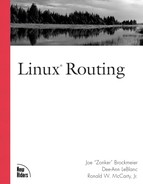Multicast Open Shortest Path First (MOSPF)
The Multicast Open Shortest Path First (MOSPF) protocol is a version of OSPF that allows for efficient routing of multicast packets (as well as unicast packets) within an autonomous system. This implementation merges both OSPF and the Internet Group Management Protocol (IGMP), which handles multicast group memberships. Even better, it keeps the best capabilities of all, including using the OSPF authentication scheme.
MOSPF tracks who is currently a member of a multicast group using the same type of back and forth querying used by the HELLO protocol. Every MOSPF router calculates its own trees. Notice the plural on “trees.” Each router calculates a separate tree for each source/destination pair. This tree reaches from the source, through the router, all the way out to the networks that contain members.
Stop and think for a second what this might mean. If MOSPF routers calculated trees for all existing multicast sources and groups in your autonomous system ahead of time, your MOSPF routers would be so busy calculating that they would be useless for directing traffic.
Instead, no tree is calculated until multicast data actually needs to travel from a source/destination pair that no tree exists for yet. Because multicasting is designed to deliver data to all group members, its packets (datagrams) drop off copies for each group member as they travel the shortest path. However, the tree is not unique to each router—as it is in OSPF. Instead, the tree’s trunk is at the router from where the data came, and all of the routers receiving and passing on the data use that same starting point for their tree. So, all routers dealing with this data are using the same shortest path tree, even though they each calculate it themselves.
Handling Ties When Building TreesIf there is a tie between paths that have equal costs, load balancing is not used. Various MOSPF implementations have specific ways of choosing which branch to use for the fastest, shortest path tree. |
Interestingly, you can mix OSPF and MOSPF routers within OSPF areas and even spread them throughout autonomous systems. To do this there just needs to be a contiguous set of routers capable of multicasting so the data can travel where it needs to go.
The program used to implement MOSPF is mrouted. There are also adjustments you need to make so the router is fully multicast-enabled. See Chapter 6, “Inside the Multicast Kernel 2.2.x Daemons,” for coverage on how to accomplish this.
